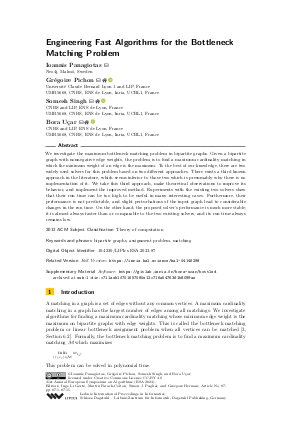Engineering Fast Algorithms for the Bottleneck Matching Problem
Authors
Ioannis Panagiotas,
Grégoire Pichon  ,
Somesh Singh
,
Somesh Singh  ,
Bora Uçar
,
Bora Uçar 
-
Part of:
Volume:
31st Annual European Symposium on Algorithms (ESA 2023)
Part of: Series: Leibniz International Proceedings in Informatics (LIPIcs)
Part of: Conference: European Symposium on Algorithms (ESA) - License:
 Creative Commons Attribution 4.0 International license
Creative Commons Attribution 4.0 International license
- Publication Date: 2023-08-30
File

PDF
LIPIcs.ESA.2023.87.pdf
- Filesize: 0.86 MB
- 15 pages
Document Identifiers
Related Versions
- Full Version https://inria.hal.science/hal-04146298
Subject Classification
ACM Subject Classification
- Theory of computation
Keywords
- bipartite graphs
- assignment problem
- matching
Metrics
- Access Statistics
-
Total Accesses (updated on a weekly basis)
0PDF Downloads0Metadata Views
Abstract
We investigate the maximum bottleneck matching problem in bipartite graphs. Given a bipartite graph with nonnegative edge weights, the problem is to find a maximum cardinality matching in which the minimum weight of an edge is the maximum. To the best of our knowledge, there are two widely used solvers for this problem based on two different approaches. There exists a third known approach in the literature, which seems inferior to those two which is presumably why there is no implementation of it. We take this third approach, make theoretical observations to improve its behavior, and implement the improved method. Experiments with the existing two solvers show that their run time can be too high to be useful in many interesting cases. Furthermore, their performance is not predictable, and slight perturbations of the input graph lead to considerable changes in the run time. On the other hand, the proposed solver’s performance is much more stable; it is almost always faster than or comparable to the two existing solvers, and its run time always remains low.
Cite As Get BibTex
Ioannis Panagiotas, Grégoire Pichon, Somesh Singh, and Bora Uçar. Engineering Fast Algorithms for the Bottleneck Matching Problem. In 31st Annual European Symposium on Algorithms (ESA 2023). Leibniz International Proceedings in Informatics (LIPIcs), Volume 274, pp. 87:1-87:15, Schloss Dagstuhl – Leibniz-Zentrum für Informatik (2023)
https://doi.org/10.4230/LIPIcs.ESA.2023.87
BibTex
@InProceedings{panagiotas_et_al:LIPIcs.ESA.2023.87,
author = {Panagiotas, Ioannis and Pichon, Gr\'{e}goire and Singh, Somesh and U\c{c}ar, Bora},
title = {{Engineering Fast Algorithms for the Bottleneck Matching Problem}},
booktitle = {31st Annual European Symposium on Algorithms (ESA 2023)},
pages = {87:1--87:15},
series = {Leibniz International Proceedings in Informatics (LIPIcs)},
ISBN = {978-3-95977-295-2},
ISSN = {1868-8969},
year = {2023},
volume = {274},
editor = {G{\o}rtz, Inge Li and Farach-Colton, Martin and Puglisi, Simon J. and Herman, Grzegorz},
publisher = {Schloss Dagstuhl -- Leibniz-Zentrum f{\"u}r Informatik},
address = {Dagstuhl, Germany},
URL = {https://drops.dagstuhl.de/entities/document/10.4230/LIPIcs.ESA.2023.87},
URN = {urn:nbn:de:0030-drops-187406},
doi = {10.4230/LIPIcs.ESA.2023.87},
annote = {Keywords: bipartite graphs, assignment problem, matching}
}
Author Details
- Université Claude Bernard Lyon 1 and LIP, France
- UMR5668, CNRS, ENS de Lyon, Inria, UCBL1, France
Supplementary Materials
-
Software
https://gitlab.inria.fr/bora-ucar/bottled
browse
 archived version
archived version
References
-
M. Benzi and B. Uçar. Preconditioning techniques based on the Birkhoff-von Neumann decomposition. Computational Methods in Applied Mathematics, 17:201-215, 2017.

-
G. Birkhoff. Tres observaciones sobre el algebra lineal. Univ. Nac. Tucumán Rev. Ser. A, 5:147-150, 1946.

-
R. Burkard, M. Dell'Amico, and S. Martello. Assignment Problems. SIAM, Philadelphia, PA, USA, 2009.

-
C. Chang, W. Chen, and H. Huang. On service guarantees for input-buffered crossbar switches: A capacity decomposition approach by Birkhoff and von Neumann. In Quality of Service, 1999. IWQoS '99. 1999 Seventh International Workshop on, pages 79-86, 1999.

-
T. A. Davis and Y. Hu. The University of Florida sparse matrix collection. ACM Trans. Math. Softw., 38(1):1:1-1:25, 2011.

-
I. S. Duff, K. Kaya, and B. Uçar. Design, implementation, and analysis of maximum transversal algorithms. ACM Transactions on Mathematical Software, 38:13:1-13:31, 2011.

-
I. S. Duff and J. Koster. The design and use of algorithms for permuting large entries to the diagonal of sparse matrices. SIAM Journal on Matrix Analysis and Applications, 20(4):889-901, 1999.

- I. S. Duff and J. Koster. On algorithms for permuting large entries to the diagonal of a sparse matrix. SIAM Journal on Matrix Analysis and Applications, 22:973-996, 2001. URL: https://doi.org/10.1137/S0895479899358443.
- F. Dufossé, K. Kaya, I. Panagiotas, and B. Uçar. Further notes on Birkhoff-von Neumann decomposition of doubly stochastic matrices. Linear Algebra and its Applications, 554:68-78, 2018. URL: https://doi.org/10.1016/j.laa.2018.05.017.
- F. Dufossé and B. Uçar. Notes on Birkhoff-von Neumann decomposition of doubly stochastic matrices. Linear Algebra and its Applications, 497:108-115, 2016. URL: https://doi.org/10.1016/j.laa.2016.02.023.
-
A. L. Dulmage and N. S. Mendelsohn. Coverings of bipartite graphs. Canadian Journal of Mathematics, 10:517-534, 1958.

-
H. N. Gabow and R. E. Tarjan. Algorithms for two bottleneck optimization problems. J. Algorithms, 9(3):411-417, 1988. Hopcroft-Karp algorithm can be used as an approximation algorithm p415.

- P. Hall. On representatives of subsets. Journal of the London Mathematical Society, s1-10(37):26-30, 1935. URL: http://jlms.oxfordjournals.org/cgi/reprint/s1-10/37/26.pdf.
-
J. E. Hopcroft and R. M. Karp. An n^5/2 algorithm for maximum matchings in bipartite graphs. SIAM Journal on Computing, 2(4):225-231, 1973.

-
K. Kaya, J. Langguth, F. Manne, and B. Uçar. Push-relabel based algorithms for the maximum transversal problem. Computers & Operations Research, 40(5):1266-1275, 2013.

-
J. Kulkarni, E. Lee, and M. Singh. Minimum Birkhoff-von Neumann decomposition. In International Conference on Integer Programming and Combinatorial Optimization, pages 343-354. Springer, 2017.

- I. Panagiotas, G. Pichon, S. Singh, and B. Uçar. Bottled: Fast algorithms for the bottleneck matching problem, April 2023. URL: https://doi.org/10.5281/zenodo.7871464.
- A. Pothen and C.-J. Fan. Computing the block triangular form of a sparse matrix. ACM Transactions on Mathematical Software, 16(4):303-324, December 1990. URL: https://doi.org/10.1145/98267.98287.
-
A. P. Punnen and K. Nair. Improved complexity bound for the maximum cardinality bottleneck bipartite matching problem. Discret. Appl. Math., 55(1):91-93, 1994.

-
R. Sinkhorn and P. Knopp. Concerning nonnegative matrices and doubly stochastic matrices. Pacific J. Math., 21:343-348, 1967.

- V. Valls, G. Iosifidis, and L. Tassiulas. Birkhoff’s decomposition revisited: Sparse scheduling for high-speed circuit switches. IEEE/ACM Transactions on Networking, 29(6):2399-2412, 2021. URL: https://doi.org/10.1109/TNET.2021.3088327.
